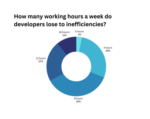
With value stream management becoming more mainstream in organizations looking to better align IT initiatives with business priorities, SD Times had the chance to produce a webinar with two of the members of the team at Allstacks, which has created a value stream intelligence platform – Adam Dahlgren, COO and head of product, and Parker Ennis, director of product marketing. We discuss cross-functional metrics and analysis, strategic priorities and a lot more. Here is an abridged transcript of that conversation:
SDT: We’ve been covering the software development industry for 20 years here at SD Times, and one of the biggest hurdles we always heard about was the disconnect between IT and what business wanted, because they were using different tools, didn’t speak the same language, and couldn’t have insights into the other side as to what’s needed. So value stream intelligence seems to be the long-awaited bridge to get the two sides to come together. But yet, this still seems to be kind of a challenge for a lot of people. Why is it so difficult?
ENNIS: I love this question. And you know, so I’ll give a brief little historical context that I think will be a good way to describe this. And it kind of comes down to why Allstacks was founded in the first place. Our CEO and co-founder was working in the health care field, senior engineering role, and had a seat at the table with leadership. You’re discussing the roadmap, strategic priorities, what’s important to the business, and sales and marketing will come with these beautiful slide decks, metrics, numbers, graphs, and show tangible data to back up questions like, ‘How are we delivering on X project? Where can we improve productivity efficiency here? And how are we delivering that value?’ It was hard for the engineering side to answer those questions. And it shouldn’t be. So that was kind of antithesis, and the reason that Allstacks was created – to understand that disconnect between the engineering side of the house and the go-to-market teams or the business side, and to create a way to bring data to the table and give engineering a voice in that boardroom.
DAHLGREN: We just find that the more complex the set of business units, use cases, teams processes are, the more value there is to be captured from putting these principles in place. And, and like Parker was saying earlier, it’s simply turning the lights on. It is amazing how difficult it is for people in these large, complex enterprises to even be able to benchmark their current state. How wrong they often are just about where they think they are, they’re the things that are on fire, they’re often wrong about what is on fire, and then the things that they think are not on fire are actually on fire. It is amazing. It’s really incredible how surprising it can be when these leaders first get a sense for, ‘Oh, this is actually this my state of affairs, this is my composite view of reality.’ That’s an exciting thing.
Read the full conversation on VSM Times.






